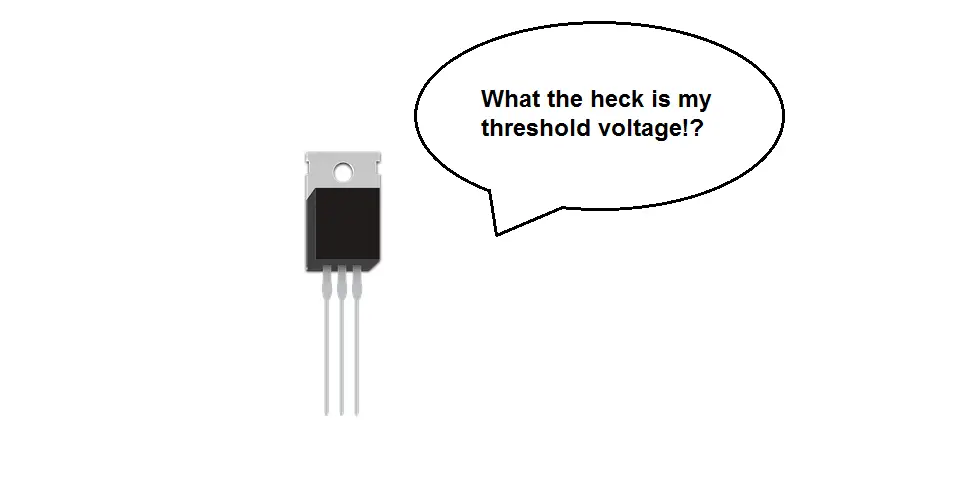A MOSFET is a type of transistor which commonly has three terminals. Like its peers, it is used for the switching and amplification of electrical signals.
Like many electrical and electronic components, MOSFETs have many important characteristics that determine how it operates.
One of these characteristics is the Threshold Voltage (Vth).
So what exactly is the threshold voltage of a MOSFET? The threshold voltage of a MOSFET is the minimum gate-to-source voltage (Vgs) required to turn the MOSFET ‘ON’ (which allows current to start flowing between source and drain).
However, there are variations of MOSFET each having different threshold voltages.
This article shall take a closer look at the MOSFET, its variations and threshold voltage.
What is a MOSFET?
Transistors are semiconducting devices that can be used either to amplify or switch electrical signals.
The MOSFET is part of the family of transistors which shares the same purpose as its peers. But, the way it goes about doing so is different.
Furthermore, it is a subset of another commonly used transistor, the Field Effect Transistor (FET).
MOSFET stands for Metal Oxide Semiconducting Field Effect Transistor.
It is a three terminal device which includes a Gate(G), Source (S), and Drain(D).
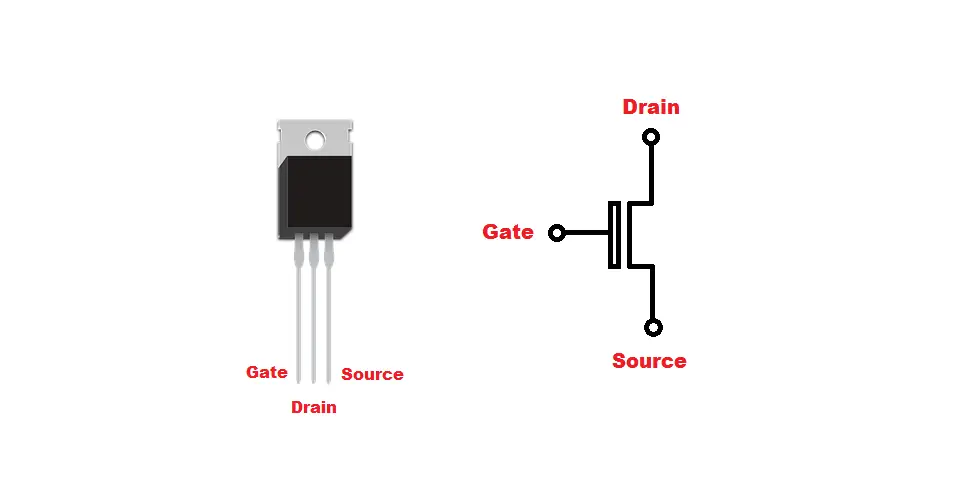
There are two main two groups of MOSFET (Enhancement and Depletion),which can either be N-Channel or P-Channel. This gives us four types of MOSFET seen below;
- Enhancement Mode N-Channel
- Enhancement Mode P-Channel
- Depletion Mode N-Channel
- Depletion Mode P-Channel
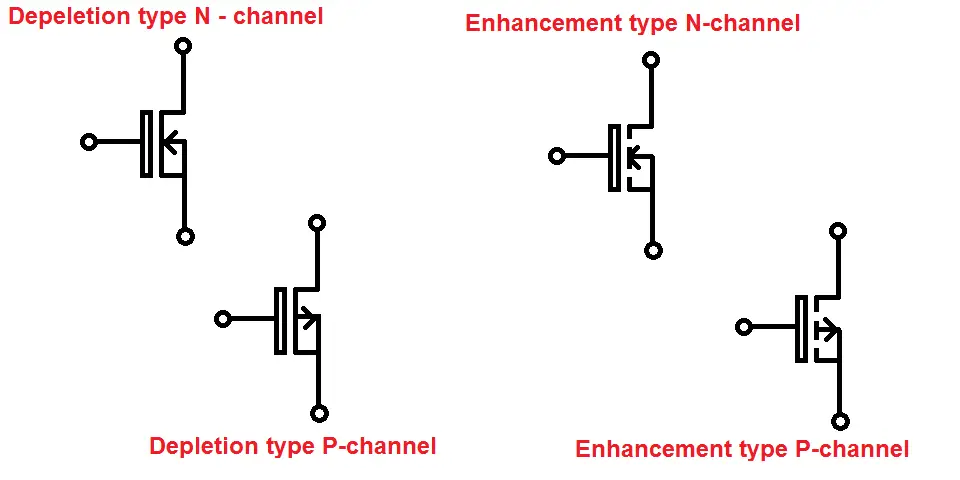
Construction of a MOSFET
In Enhancement type MOSFETs, there is no physical connection between the source and drain, hence the broken lines in its symbol.
On the other hand, depletion MOSFETs have a small semiconducting strip that connects the source and drain terminals.
Below is an image that shows the basic construction of the MOSFET.
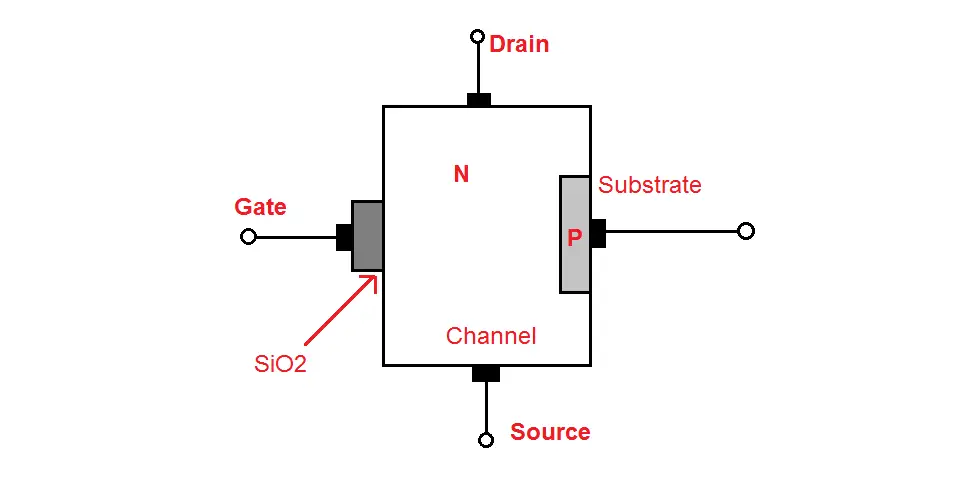
The Gate terminal is connected to a substrate where an oxide layer (SiO2) is placed. The purpose of the oxide layer is to act as an insulator.
The general construction of a MOSFET consists of a lightly doped substrate which is diffused by a heavily doped region.
The substrate used ultimately determines whether it is a P-type or N-type MOSFET.
As we saw above, MOSFETs are either Enhancement or Depletion.
N-Channel Enhancement MOSFET
The source and drain in a N-Channel Enhancement MOSFET consist of a N-type semiconductor which is heavily doped and the substrate is a P-type semiconductor.
Electrons are the main charge carriers.
P-Channel Enhancement MOSFET
On the other hand, the source and drain of P-Channel Enhancement MOSFETs are of a P-type semiconductor which is heavily doped, and the substrate is a N-type semiconductor. Holes are the major carriers here.
In enhancement mode, the source and drain are isolated.
N-Channel Depletion MOSFET
In N-channel depletion MOSFETs the source and drain are connected by a small strip of material that is a semiconductor of N-type. The substrate is a P-type semiconductor.
The main charges are electrons while the source and drain are heavily doped.
P-Channel Depletion MOSFET
The P-channel depletion MOSFET is the opposite of the N-channel, as the strip of semiconducting material connecting the source and drain is P-type. The substrate is N-type.
The main carriers are holes.
Regions of operation of a MOSFET
The MOSFET has three major areas of operation which include;
- Cut-Off region
- Saturation Region
- Linear/Ohmic Region
Cut-off region
When the MOSFET is in the cut-off region the device is considered to be in its ‘OFF’ state. When it is OFF, no current flows through it.
Just like when a mechanical switch is open and stops the flow of current as well.
Saturation region
Saturation is when the current flow through the MOSFET is a constant value. In this region it behaves like a closed switch allowing current to flow freely.
Linear/Ohmic region
Last but not least is the Linear/Ohmic region.
In this region of operation, an increase of voltage across the drain and source sees an increase in current through the MOSFET as well.
The threshold voltage of the MOSFET
When there is no voltage present between the gate and source terminals, the MOSFET is operating in the cut-off region.
In this region the MOSFET is ‘OFF’ as no current can flow from the source to drain.
In order to allow current to flow freely from the source to drain, we need a conducting path. This conducting path is created when the MOSFET is operating in the saturation region.
But in order to get to the saturation region we need to turn the MOSFET ‘ON’.
To do so we need to apply a sufficient amount of voltage between the gate and source terminals known as VGS.
The minimum amount of voltage required to enter the saturation region and start conducting current is known as the Threshold Voltage or VTH.
When VGS > VTH, the MOSFET is now said to be ‘ON’.
Threshold voltage for the different types of MOSFET
We know that there are derivatives of the MOSFET.
But, are the threshold voltages the same for all four?
The table below summarises the conditions for the different threshold voltages for the various types of MOSFET.
| Type of MOSFET | Region of operation | ||
| Cut-Off | Saturation | Linear/Ohmic | |
| Enhancement N-Channel | VGS < VTH | VGS > VTH and VDS > VP | VGS > VTH andVDS < VP |
| Enhancement P-Channel | VGS > -VTH | VGS < -VTH andVDS < -VP | VGS < -VTH andVDS > -VP |
| Depletion N-Channel | VGS < -VTH | VGS > -VTH andVDS > VP | VGS > -VTH andVDS < VP |
| Depletion P-Channel | VGS > VTH | VGS < VTH andVDS < -VP | VGS < VTH andVDS > -VP |
*The information in this table is thanks to https://www.electrical4u.com/mosfet-characteristics/ . For a more in-depth explanation check them out.
VTH = threshold voltage
VGS = gate-to-source voltage
VDS = drain-to-source voltage
VP = pinch-off voltage
What is the threshold voltage required to turn a MOSFET on?
So, how much voltage does it take to put the MOSFET on?
This comes down to the two main regions of operation of a MOSFET;
- Cut-Off
- Saturation
As we just learnt, when the MOSFET is ‘OFF’, it is in the cutoff region.
The saturation region is when the MOSFET is ‘ON’ and current can flow freely from source to drain. This is when the maximum gate voltage is applied and results in the maximum amount of current that can flow.
To get to this region of operation VGS > VTH.
The exact threshold voltage will differ for the four types of MOSFET, as there are many factors like materials used, manufacturer, oxide thickness, etc, which will determine the threshold voltage value.
To find out the exact threshold voltage for a particular MOSFET, you will have to look up its datasheet which will have the necessary values.
Threshold voltage is usually denoted VGS(TH) in most datasheets.
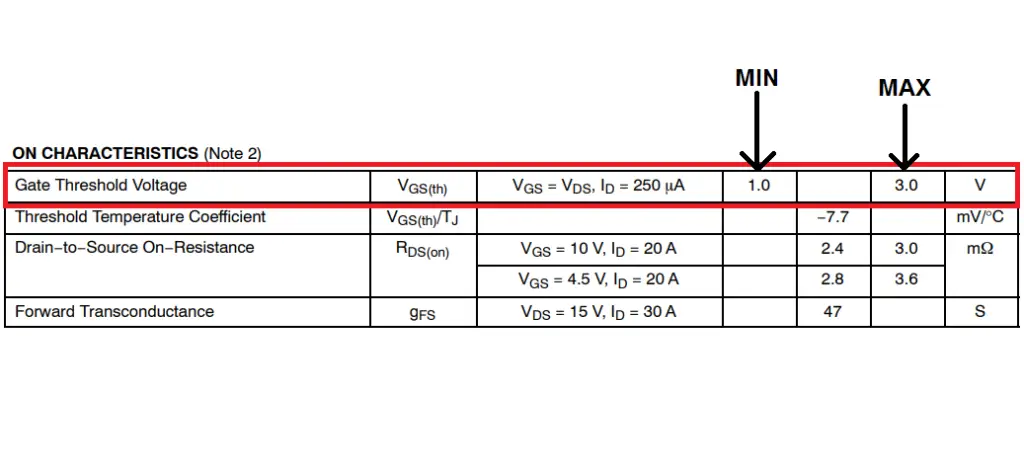
Is the threshold voltage of the MOSFET constant?
You might be wondering if the MOSFET is exactly like a switch, in the sense that when it is closed the maximum amount of current can flow.
The answer to that is no. The amount of current that flows is dependent on the amount of voltage applied to the gate and source (Vgs).
So, when there is more to the question of whether threshold voltage is constant or not.
There is a range of threshold voltages that range from minimum to maximum.
When the amount of Vgs is greater than Vth, this will allow current to start flowing. But, this is not the maximum amount of current that can flow (like when a switch is closed).
The amount of drain current that can flow is determined by how much voltage is applied to the gate and source and also sits between the range of minimum and maximum threshold voltage.
Lower values of Vgs will conduct less drain current, while higher values will allow higher amounts of current to flow.
MOSFETs have a Drain Characteristics Curve that shows the amount of current for different Vgs values.
Factors that can affect the threshold voltage of a MOSFET
Performance of electronic components can be affected by internal or external factors and the MOSFET is no different.
The threshold voltage of MOSFET can be influenced by a few factors which include;
- Oxide Thickness
- Temperature
- Random dopant Fluctuation
Oxide thickness
The type of oxide chosen to construct the MOSFET, as well as its thickness plays a large part in the threshold voltage.
Thickness of the oxide layer shares a directly proportional relationship with threshold voltage which means the smaller the oxide layer, the smaller the threshold voltage and vice versa.
Temperature
While there is no direct relationship the side effects of temperature do affect the threshold voltage with the variation being -4mV/K or -2mV/K which is dependent on the doping level.
A change in temperature around 30 °C can see a change in threshold voltage of around 500mV.
Random dopant fluctuation
Random Dopant Fluctuation or RDF is a process where the amount of random dopant fluctuation is reduced by lowering the dopant density.
The RDF in the channel region of MOSFETs can vary certain characteristics, like threshold voltage.

